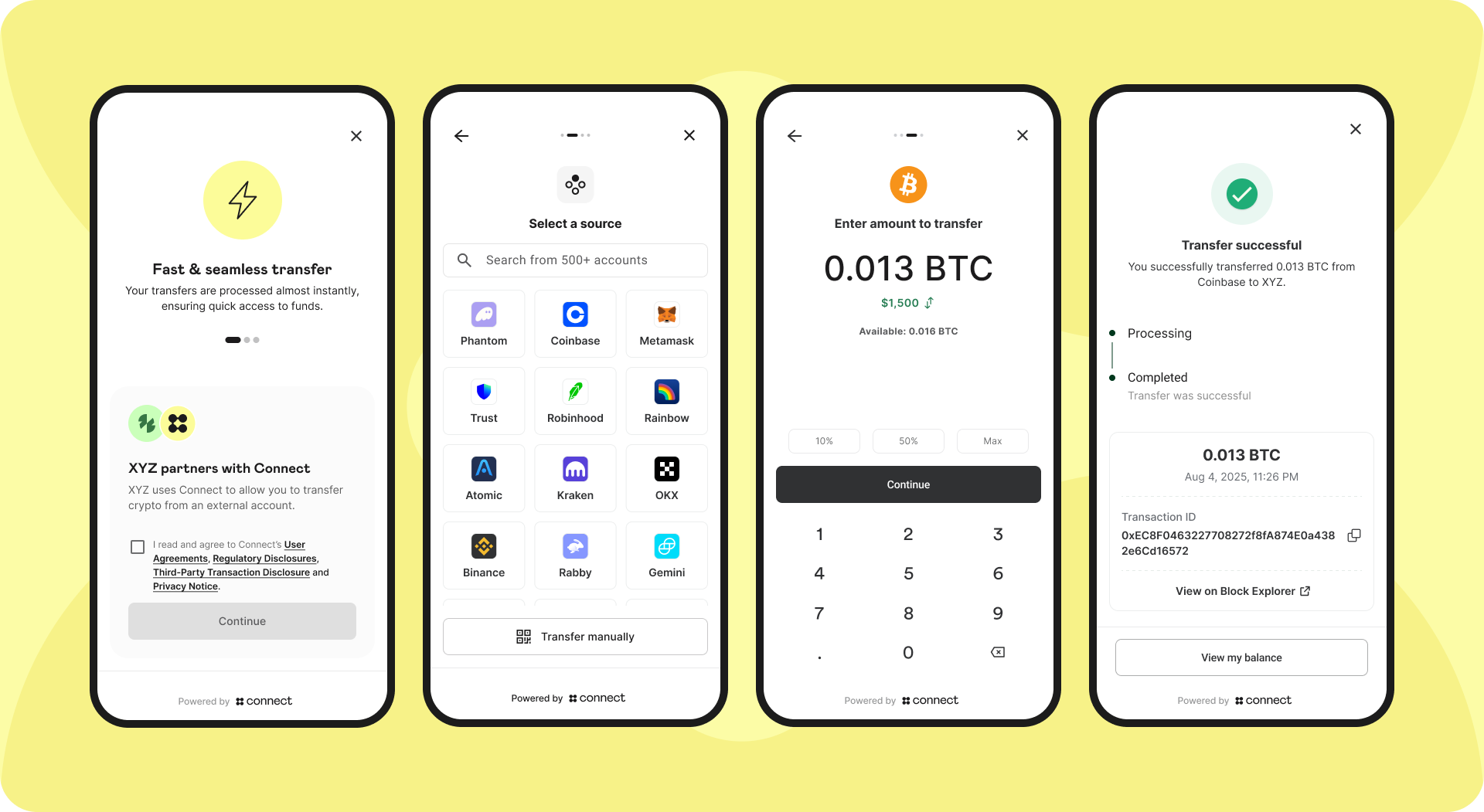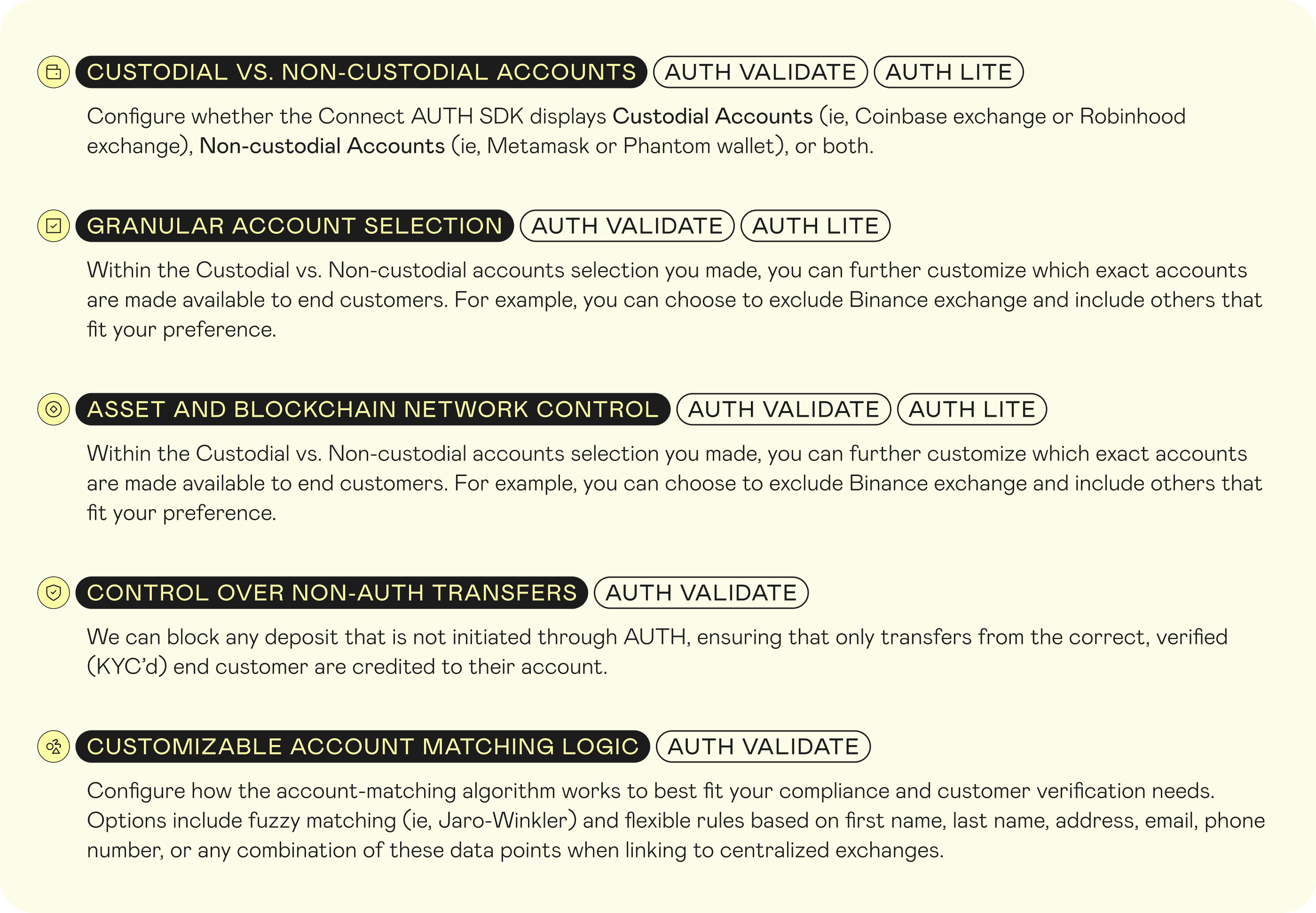Auth
Provide a smooth user experience by enabling account-to-account transfers without the need to copy and paste wallet addresses or choose the right chain.

Introduction
Our Auth product is a seamless and secure solution for enabling direct account-to-account transfers between custodial accounts (ie, exchanges, fintechs, etc) and non-custodial accounts.
Backed by a deep network of supported venues, Auth eliminates manual and error-prone transfer steps leading to fragmented user experiences. Our platform handles secure authentication, initiates transfers, and ensures visibility and adherence to key compliance/AML standards. Offered through easy-to-integrate SDK's, Auth is built for scale, security, and seamless user journeys.

See full list of Auth Integrations →
Auth Lite vs. Auth Validate
You can choose between 2 versions of Auth:
Auth Lite
- Purely a tech connectivity product, there is no account-matching validation performed between the end user account and the external account being connected
- Enables faster and more flexible integrations with minimal friction for end users
- Best suited for low-risk or closed-loop environments where account ownership verification is not required
Auth Validate
- Performs account-matching between the KYC’d customer record and the external account being connected
- Adds a layer of identity verification to reduce the risk of misdirected transfers or fraud
- Supports compliance with internal policies or regulatory requirements requiring account ownership validation
For select Platform partners, zerohash may provide a combination of AUTH Lite and AUTH Validate to meet the greater complexity of their integration and desired level of risk mitigation.
Configuration Rules
You have the ability to tailor your Auth setup per your own preferences. See below list of configuration options:

Account Match Logic
zerohash can perform account matching between the user in our system and the corresponding account within the external exchange system.
Logic
By default, our out-of-the-box name matching logic performs a standard comparison of First Name and Last Name fields. We apply a string similarity algorithm called Jaro-Winkler, which generates a score between 0 and 1:
- A score of 1.0 indicates a perfect match
- Lower scores reflect less similarity between the names
We recommend a default threshold of 0.75 (ie, 75%), but this value is fully configurable based on your organization’s needs and risk tolerance.
Customizations and support
If you have further questions about the algorithm or need guidance on configuring the appropriate match threshold, please reach out to your zerohash representative. They can connect you with our Product, Engineering, or Compliance teams for more in-depth support.
Different applications of Auth
Auth can be offered as a standalone product, or bundled within one of our Move products (Payouts, Payins, or Account Funding).
Auth - Standalone
Auth - Standalone enables your users to seamlessly transfer crypto and stablecoin assets to and from their accounts on your platform - whether they're coming from custodial wallets or non-custodial sources. Think of it as a more user-friendly, integrated alternative to traditional deposit and withdrawal flows.
Auth - Bundled with Move
Zerohash offers 3 Move products:
- Payouts
- Payins
- Account Funding
You can choose to enabled Auth for any of these products. Example use cases:
- Payouts: Allow users to authenticate with their MetaMask wallet via our SDK and initiate payouts directly from their marketplace balance.
- Payins: Let users authenticate with their Coinbase exchange account via our SDK and pay for goods or services directly from their balance.
- Account Funding: Enable users to connect their Gemini account through our SDK and initiate transfers to fund their prediction market balance.
Updated 30 days ago
